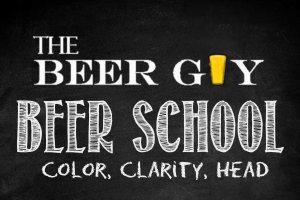 Our second lesson in the art of enjoying great beer involves your sense of vision. For years the world has thought of beer visually as crystal clear, yellow in color and with robust carbonation streaming up the glass. While that presentation is great for many styles, it is not always what beer should look like. As you will learn, the way a beer looks can be influenced by style, temperature, the glass in which it is served and even the skill of the bartender.
Our second lesson in the art of enjoying great beer involves your sense of vision. For years the world has thought of beer visually as crystal clear, yellow in color and with robust carbonation streaming up the glass. While that presentation is great for many styles, it is not always what beer should look like. As you will learn, the way a beer looks can be influenced by style, temperature, the glass in which it is served and even the skill of the bartender.
When evaluating the appearance of a beer there are three things you should look for:
- Color
- Clarity
- Head Retention
Let’s take a look at each of these characteristics individually.
Color
Today’s craft and import beers run the gamut of the color spectrum from pale straw to golden, amber, copper, orange, brown, black, and everything in between. Dictated solely by the style of the beer, color is not an indication of whether a beer will taste good it is merely an indication of which malts and adjuncts the brewer used while making the beer. One color is not necessarily better than another when it comes to beer. It’s all a matter of preference.
In the world of competitive beer brewing – yes, there is such a thing – judges use a style guide to determine the general color a given beer style should have. One of the most accepted and respected guide is the Beer Judge Certification Program Style Guidelines. This extensive guide catalogs how over 75 general beer styles should look, smell and taste. It is well worth a look if you really want to know all the details of how a beer should look in your glass.
But, for the casual beer-drinker, we can simplify the color issue.


Light: Pilsners, Marzen/Oktoberfest, Weizen



Amber: Scottish Ale, Vienna-style Lager, Dunkelweizen, Irish Ale, Amber/Red Ale, Barleywine

Black: Stout, Porter, Milk Stout, Irish Dry Stout, Oatmeal Stout, Black IPA
Of course, there are plenty of other styles not represented on the above chart. Styles like Brown Ales that are, well, brown and Schwarzbier and dark lagers that lean towards the amber side of brown. But, for the most part, this chart should help give you an idea of how certain styles should fit on the color scale.
In general, if the beer falls within the expected color spectrum of its style, the brewer followed good procedure and used fresh, quality ingredients. Beer that is far outside of the expected color for the style may still be good, but treat it a bit more cautiously in your expectations.
Clarity
Crystal clear or cloudy, that is the question. And the answer is a definitive; it depends. While the quest for beer clarity is a goal to most modern brewers, there are certain styles of beer that are inherently cloudy and that is perfectly okay.
Historically, beer was rarely crystal clear. Indeed, the suspended particles were desireable because they are what made beer the nourishing drink that it was. Sure there were a few styles prized for their clarity like Pilsners and other German lagers, but the vast majority of beer was anything from hazy to outright cloudy. Today, for beers like Wits, Hefeweizens and other unfiltered styles a cloudy appearance is perfectly appropriate.
But, beer styles other than those mentioned above and a few others, today most beer is expected to be clear in order to be properly brewed. There are several factors that contribute to a beer’s clarity including:
- Suspended proteins
- Unsettled yeast
- Other particles
In the world of beer tasting there is a phenomenon known as chill haze. When a beer is not boiled properly during and then cooled fast enough chill haze can set in. When this occurs and the beer is refrigerated, the proteins still in the brew are driven out of the solution causing it to take on a hazy appearance in the glass. While it rarely changes the flavor of the beer, it does make it less appealing to look at.
Another cause of hazy or cloudy beer is the presence of yeast that has not settled to the bottom yet. Certain yeast strains are bred to have a high degree of flocculation or the ability to settle out of beer quickly. Others, like those used in Witbiers and Hefeweizens flocculate much slower and cause the cloudy appearance that is perfectly normal for those styles.
Brewers will often store beer in a cool place or even refrigerate it to increase flocculation in yeast. A perfect example of this is the practice of lagering employed by the Germans who, in the old days, stored beer in caves for several months before serving it. The time spent sitting undisturbed in the lagering caves allowed the yeast to fall to the bottom of the barrel and produced a much clearer brew.
Other particles that remain in beer for a long period of time include things like hop particles, fruit pectins and any other adjuncts that may be added. Beers like double and triple IPAs will often appear hazy due to the higher amount of hop residue that stays in suspension in the beer. Dry-hopping, a practice of adding hops to a beer after the original boil, also contributes to a decrease in beer clarity.
To increase the clarity of beer brewers will often add materials like Irish Moss, isinglass and whirlfloc. They may also employ a filter or whirlpool the remove solids.
For your enjoyment, though, just keep in mind that some beers are meant to be cloudy. As a rule of thumb, wheat beers or beers made with a large amount of wheat in the grain bill are meant to be cloudy. Also, keep in mind that chill haze, while not attractive will likely not affect the flavor of your beer.
Head Retention
For years the excepted standard of two fingers so foam at the top of a well-poured glass of beer was what all good bartenders strived for. Another tell-tae sign of good head is the lacing – known as Belgian or Brussels lace – left on the sides of the glass as you drink the beer. But, if the head did not form it is not always the bartender’s fault. There is a lot of chemistry and artistry that goes into brewing beer that will form and perfect, fluffy head.
During travels in Belgium, I noticed a bartender mis-poured a beer. Before she would serve the beer to her guest, she made sure there was head on the beer by taking two coffee stir sticks and whipping one up. By doing this she not only saved an innocent beer from being wasted, but she also insured her guest got full enjoyment from his beer. The Belgians are fanatics about beer and would not dream of serving a beer without a proper head. But, why?
The foam at the top of your beer serves a number of purposes; most importantly it captures and disburses aromatics that lead to an increased enjoyment of beer. But, it also provides part of the beers feel in your mouth and is an indication of the relative health of the beer.
So, what kills foam? Soap residue in a glass and oils. Glassware used for beer must be impeccably clean, any soap or cleanser left in the glass can kill a foam head and leave a beer with a surface smoother than a lake on a windless day. Oils will do the same thing. For instance, lipstick and lip balms react with the foam a cause it to quickly dissipate. This is why the old trick of touching your nose and then sticking your finger in an overflowing beer or soda works.
But, there are other factors to a rich head including the type and alcohol content of the beer. Just as Witbiers and Hefeweizens are typically cloudy, they are also blessed with glorious, billowy heads because of their high concentration of compounds that enhance foam production. Higher alcohol beers, on the other hand, generally have lower amounts of head.
So, how can you insure the best possible head for your beer? Pour your beer straight down the middle of your glass. Sure, this goes against the steps given on the perfect pour instructions last week, but if head is what you want, this is how to get the most.
Let’s review:
The color of your beer depends on the style you are drinking and can indicate whether the brewer hit the mark for the style he was going for. Clarity can be an indication of improper boil and cool down procedures or, depending on the style can be perfectly acceptable. And, head retention can be affected by the cleanliness of your local pub or tap room or it can be an indication of the alcohol content of the beer.
Next week: Ooh, ooh that smell! What effects the aroma and how it should affect your perception of beer.

Click HERE to sign up now!
